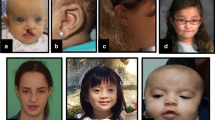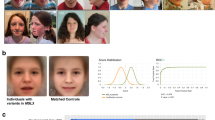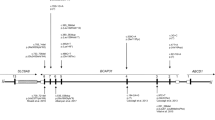Abstract
X-linked mental retardation (XLMR) is an inherited condition that causes failure to develop cognitive abilities, owing to mutations in a gene on the X chromosome. The latest XLMR update lists up to 136 conditions leading to 'syndromic', or 'specific', mental retardation (MRXS) and 66 entries leading to 'nonspecific' mental retardation (MRX)1. For 9 of the 66 MRX entries, the causative gene has been identified1. Our recent discovery of the contiguous gene deletion syndrome ATS-MR (previously known as Alport syndrome, mental retardation, midface hypoplasia, elliptocytosis, OMIM #300194), characterized by Alport syndrome (ATS) and mental retardation (MR), indicated Xq22.3 as a region containing one mental retardation gene2,3. Comparing the extent of deletion between individuals with ATS-MR and individuals with ATS alone allowed us to define a critical region for mental retardation of approximately 380 kb, containing four genes4,5,6. Here we report the identification of two point mutations, one missense and one splice-site change, in the gene FACL4 in two families with nonspecific mental retardation. Analysis of enzymatic activity in lymphoblastoid cell lines from affected individuals of both families revealed low levels compared with normal cells, indicating that both mutations are null mutations. All carrier females with either point mutations or genomic deletions in FACL4 showed a completely skewed X-inactivation, suggesting that the gene influences survival advantage. FACL4 is the first gene shown to be involved in nonspecific mental retardation and fatty-acid metabolism.
This is a preview of subscription content, access via your institution
Access options
Subscribe to this journal
Receive 12 print issues and online access
$209.00 per year
only $17.42 per issue
Buy this article
- Purchase on Springer Link
- Instant access to full article PDF
Prices may be subject to local taxes which are calculated during checkout





Similar content being viewed by others

References
Chiurazzi, P., Hamel, B.C.J. & Neri, G. XLMR genes: update 2000. Eur. J. Hum. Genet. 9, 71–81 (2001).
Jonsson, J. et al. Alport syndrome, mental retardation, midface hypoplasia, and elliptocytosis: a new X-linked contiguous gene deletion syndrome? J. Med. Genet. 35, 273–278 (1998).
Vitelli, F. et al. Identification and characterization of a higly conserved protein absent in the Alport S. (A), Mental retardation (M), Midface hypoplasia (M), and Elliptocytosis (E), contiguous gene deletion syndrome. Genomics 55, 335–340 (1999).
Meloni, I. et al. Alport syndrome and mental retardation: clinical and genetic dissection of the contiguous gene deletion syndrome in Xq22.3 (ATS-MR). J. Med. Genet. 39, (in the press).
Piccini, M. et al. KCNE1-like gene is deleted in AMME contiguous gene syndrome: identification and characterisation of the human and mouse homologs. Genomics 60, 251–257 (1999).
Piccini, M. et al. FACL4, a new gene encoding long chain acyl-CoA synthetase 4, is deleted in a family with Alport syndrome, elliptocytosis and mental retardation. Genomics 47, 350–358 (1998).
des Portes, V. et al. X-linked non-specific mental retardation (MRX) linkage studies in 25 unrelated families: the European XLMR consortium. Am. J. Med. Genet. 85, 263–265 (1999).
Raynaud, M. et al. Systematic analysis of X-inactivation in 19 XLMR families: extremely skewed profiles in carriers in three families. Eur. J. Hum. Genet. 8, 253–258 (2000).
Herold, H. et al. TAP (NXF1) belongs to a multigene family of putative RNA export factors with a conserved modular architecture. Mol. Cell. Biol. 20, 8996–9008 (2000).
Cao, Y., Pearman, A.T., Zimmerman, G.A., McIntyre, T.M. & Prescott, S.M. Intracellular unesterified arachidonic acid signals apoptosis. Proc. Natl Acad. Sci. USA 97, 11280–11285 (2000).
Zappella, M., Meloni, I., Longo, I., Hayek, G. & Renieri, A. Preserved speech variants of the Rett syndrome: molecular and clinical dissection. Am. J. Med. Genet. 104, 14–22 (2001).
Nielsen, J.B. et al. MECP2 mutations in Danish patients with Rett syndrome: high frequency of mutations but no consistent correlations with clinical severity or with the X chromosome inactivation pattern. Eur. J. Hum. Genet. 9, 178–184 (2001).
Cao, Y., Traer, E., Zimmerman, G.A., McIntyre, T.M. & Prescott, S.M. Cloning, expression, and chromosomal localization of human long-chain fatty acid-CoA ligase 4 (FACL4). Genomics 49, 327–330 (1998).
Cao, Y., Murphy, K.J., McIntyre, T.M., Zimmerman, G.A. & Prescott, S.M. Expression of fatty acid-CoA ligase 4 during development and in brain. FEBS Lett. 467, 263–267 (2000).
Faergeman, N.J. & Knudsen, J. Role of long-chain fatty acyl-CoA esters in the regulation of metabolism and in cell signaling. Biochem. J. 323, 1–12 (1997).
Merienne, K. et al. A missense mutation in RPS6KA3 (RSK2) responsible for non-specific mental retardation. Nature Genet. 22, 13–14 (1999).
Meloni, I. et al. A mutation in the Rett syndrome gene, MECP2, causes X-linked mental retardation and progressive spasticity in males. Am. J. Hum. Genet. 67, 982–985 (2000).
Couvert, P. et al. MECP2 is highly mutated in X-linked mental retardation. Hum. Mol. Genet. 10, 941–946 (2001).
Burgemeister, B., Blum, L.H. & Lorge, I. Manual for the use of the Columbia Mental Maturity Scale (The Psychological Corporation, New York, 1954).
Goodglass, H. & Kaplan, E. Boston Diagnostic Aphasia Examination (Psychological Assessment Resources, Odessa, 1983).
McCarthy, D. Manual for the McCarthy Scales of Children's Abilities (The Psychological Corporation, New York, 1972).
Wechsler, D. Wechsler Memory Scale-Revised Manual. (The Psychological Corporation, New York, 1987).
Gauthier, L., Dehaut, F. & Joanette, Y. The Bell test: a quantitative and qualitative test for visual neglect. Int. J. Clin. Neuropsychol. 11, 49–54 (1989).
American Psychiatric Association. Diagnostic and statistical manual of mental disorders. DSM-IV (American Psychiatric Association, Washington DC, 1994).
Pegoraro, E. et al. Detection of new paternal dystrophin gene mutations in isolated cases of dystrophinopathy in females. Am. J. Hum. Genet. 54, 989–1003 (1994).
Stuhlsatz-Krouper, S.M., Bennett, N.E. & Schaffer, J.E. Substitution of alanine for serine 250 in the murine fatty acid transport protein inhibits long chain fatty acid transport. J. Biol. Chem. 273, 28642–28650 (1998).
Tanaka, T., Hosaka, K. & Numa, S. Long-chain acyl-CoA synthetase from rat liver. Methods Enzymol. 71, 334–341 (1981).
Watkins, P.A. et al. Disruption of the Saccharomyces cerevisiae FAT1 gene decreases very long-chain fatty acyl-CoA synthetase activity and elevates intracellular very long-chain fatty acid concentrations. J. Biol. Chem. 273, 18210–18219 (1998).
Malhotra, K.T., Malhotra, K., Lubin, B.H. & Kuypers, F.A. Identification and molecular characterization of acyl-CoA synthetase in human erythrocytes and erythroid precursors. Biochem. J. 344, 135–143 (1999).
Black, P., Zhang, Q., Weimar, J. & DiRusso, C. Mutational analysis of a fatty acyl-coenzyme A synthetase signature motif identifies seven amino acid residues that modulate fatty acid substrate specificity. Biol. Chem. 272, 4896–4903 (1997).
Acknowledgements
This work was supported by a grant from Telethon (Italy; to A.R.), by INSERM (France) and by the Fondation pour la Recherche Medicale. We are grateful for the clinical support of C. Moraine and C. de Baracé. We also appreciate the contribution of A-D. Ayrault, S. Briault, R. Fulceri and R. Giunti. We thank L. Lozzi for synthetic peptide generation.
Author information
Authors and Affiliations
Corresponding author
Ethics declarations
Competing interests
The authors declare no competing financial interests.
Rights and permissions
About this article
Cite this article
Meloni, I., Muscettola, M., Raynaud, M. et al. FACL4, encoding fatty acid-CoA ligase 4, is mutated in nonspecific X-linked mental retardation. Nat Genet 30, 436–440 (2002). https://doi.org/10.1038/ng857
Received:
Accepted:
Published:
Issue Date:
DOI: https://doi.org/10.1038/ng857
This article is cited by
-
Cell death inhibitors protect against brain damage caused by cardiac ischemia/reperfusion injury
Cell Death Discovery (2021)
-
HMGB-1 and TGFβ-1 highlight immuno-inflammatory and fibrotic processes before proteinuria onset in pediatric patients with Alport syndrome
Journal of Nephrology (2021)
-
Identification of MiR-211-5p as a tumor suppressor by targeting ACSL4 in Hepatocellular Carcinoma
Journal of Translational Medicine (2020)
-
Dynamic changes in the brain protein interaction network correlates with progression of Aβ42 pathology in Drosophila
Scientific Reports (2020)
-
Neurobiological roots of psychopathy
Molecular Psychiatry (2020)


